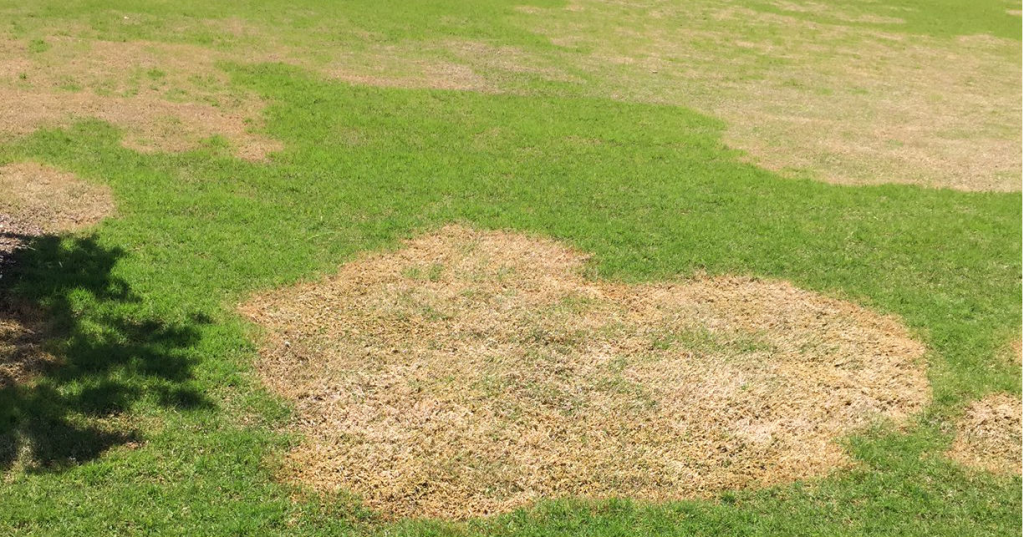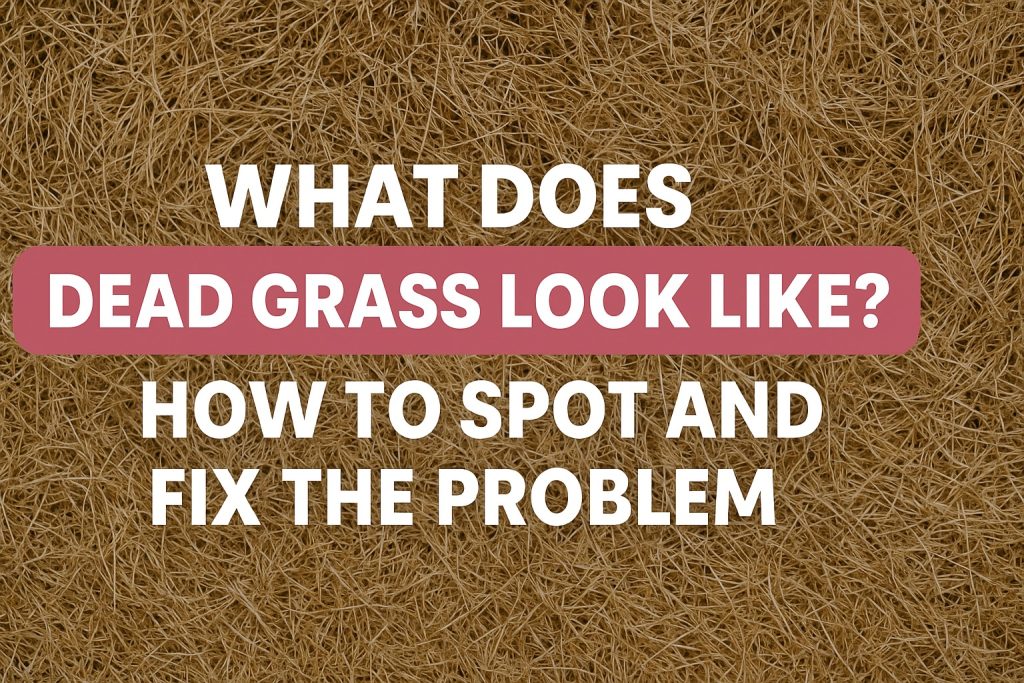A healthy lawn is a point of pride. It’s also a sign that the soil, water, and sunlight are working in balance. But when grass starts to turn yellow or brown, it raises questions. Is it dead? Is it just dormant? Should you give up or water more?
Let’s clear up the confusion. Dead grass and dormant grass can look very similar, but they’re not the same. If you catch it early, you might save your lawn. If not, you could waste time and money trying to fix something that’s already gone.
This guide will help you spot the difference, understand why grass dies, and show you what to do next.

Common Signs That Grass Is Dead, Not Dormant
Dormant grass is sleeping. Dead grass is… well, gone. But the symptoms often overlap. Here’s how to tell when your grass has passed the point of no return.
1. It Doesn’t Bounce Back
When you water dormant grass, it should green up in a week or two. Dead grass stays brown and brittle no matter what. Try giving it a deep soak. If nothing changes in 10–14 days, it’s probably dead.
2. It Pulls Out Easily
Dead grass loses its grip on the soil. If you can tug on it and it comes out with little effort, the roots have likely died. Dormant grass, by contrast, stays firmly rooted even when dry.
3. It’s the Same Color Everywhere
Dead patches often have a uniform, straw-like tone. Dormant grass may have hints of green, especially near the base. Look close. If the whole blade is dry and tan from tip to base, that’s a bad sign.
4. There’s No New Growth
Look for new shoots or tiny green blades. Even in dormancy, some grass tries to grow when temperatures are right. Dead grass won’t do this. It just sits there—unchanging, lifeless.
What Dead Grass Looks Like in Different Seasons
Grass acts differently depending on the time of year. So does dead grass. Let’s look at the signs by season.
Spring
Spring should bring fresh green growth. If your lawn still looks brown while the neighbors’ yards turn lush, that’s a clue. Rake the area. If nothing green lies under the surface, your grass might not be coming back.
Summer
High heat and drought often cause grass to go dormant. But dead grass doesn’t recover with water. If you water for weeks with no improvement, it’s time to accept that the patch is likely dead.
Also, dead grass in summer might crunch underfoot. That crispy sound? Not a good sign.
Fall
Cooler temperatures usually mean grass bounces back from summer stress. If parts of your lawn stay dry and dull while the rest revives, those areas may be dead. You’ll often see patchy spots that don’t match the healthy sections.
Winter
Dead grass can hide under snow or frost, but you’ll usually see signs before the freeze hits. If it was brown, thin, and lifeless before winter, chances are it’s not coming back in spring. Winter dormancy is normal—but dead grass doesn’t come back with the thaw.
How to Tell the Difference Between Dead and Dying Grass
It’s tricky. Dying grass still has a chance, but dead grass is beyond help. Here’s how to tell which is which.
Color at the Base
Part the blades and look at the base near the soil. Dying grass may still be green near the root. Dead grass will be brown or gray from top to bottom.
Texture
Dying grass feels dry, but not crispy. It bends a little before it breaks. Dead grass feels like straw and snaps easily when you touch it.
Smell
Yes—smell it. Dying grass sometimes has a faint earthy smell, like damp soil. Dead grass has no scent at all. Or worse, it smells musty from rot.
Reaction to Water
Water your lawn deeply. Then wait. If you see any sign of life after a week—new shoots, green tips—it’s dying, not dead. If there’s no change, it’s done.

Check This Out: When To Apply Winter Lawn Fertilizer: Timing For Healthy Grass
Causes of Dead Grass: Sun, Shade, Pets, and More
Grass can die for lots of reasons. Knowing what caused the problem helps you stop it from happening again.
1. Too Much Heat
Direct sun during hot months can scorch your lawn. Some grasses can handle it. Others can’t. Without enough water, grass burns out and dies. You’ll see large, sun-bleached areas—especially in the afternoon sun.
2. Not Enough Sun
On the flip side, deep shade can also kill grass. If trees or fences block sunlight, grass thins out and weakens. Moss or weeds might take over. Eventually, it just gives up.
3. Pet Urine
Dog spots are classic. The high nitrogen in urine burns the grass. At first, it turns yellow. Then it goes brown. If left untreated, those patches die off. Look for round, coin-sized brown spots—usually in the same areas.
4. Overwatering
Believe it or not, too much water can drown your lawn. Roots need oxygen. If they sit in soggy soil too long, they rot. The grass wilts and dies from the root up. Fungal growth can also take hold in wet conditions.
5. Underwatering
No water, no life. In drought, some grasses go dormant. But extended dry spells can kill them entirely. You’ll notice cracks in the soil and grass that feels like paper.
6. Lawn Diseases
Fungal diseases can destroy patches of grass fast. Brown patch, dollar spot, and rust are common culprits. Look for strange patterns—like circles or streaks—and discoloration that spreads over time.
7. Poor Soil
If your soil is compacted or lacks nutrients, roots can’t grow. Shallow roots mean weak grass. Eventually, it fades out. Clay-heavy soils are especially prone to this.
8. Chemical Burns
Fertilizers and weed killers, when misused, can scorch your lawn. Too much nitrogen or herbicide can “burn” the grass. This damage often shows up quickly—within a day or two of application.

Explore This Topic: 5 Bugs That Resemble Termites (And How To Tell Them Apart)
What Healthy Grass Should Look Like for Comparison
Sometimes, to know what’s wrong, you need to see what’s right.
Color
Healthy grass has a strong, even green color. Some varieties have darker greens than others, but all should be vibrant.
Texture
It feels soft and springy underfoot—not rough, not crunchy. When you step on it, it bounces back.
Root Strength
Try pulling up a small clump. If it’s hard to remove, that’s good. Strong roots hold tight to the soil. Healthy grass stays anchored.
Growth Pattern
It grows evenly, not in patches. If the grass looks like a patchwork quilt, something’s wrong.
No Bald Spots
A healthy lawn fills in naturally. Bald spots mean something is stressing the grass—foot traffic, pets, pests, or disease.
Conclusion
Dead grass isn’t always the end of the road. But recognizing it early helps you act fast. Dormant grass can wake up with care. Dying grass might bounce back if the roots are still alive. Dead grass? It’s not coming back—but you can reseed, patch, or start fresh.
Look closely. Feel the blades. Smell the soil. Water the area and watch. Grass talks—it just speaks in color, texture, and time.
Don’t panic if your lawn isn’t perfect. Even the best yards get stressed. What matters is knowing what you’re dealing with and what steps to take next.
Because sometimes, saving your lawn starts with learning what dead grass really looks like.

